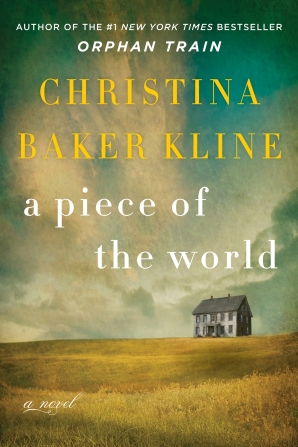
Book: A Piece of the World
Author: Christina Baker Kline
Genre: Fictional Memoir
Hardback, 309 pages
A friend loaned this book to me with a positive recommendation. I had not read Orphan Train, Christina Baker Kline’s #1 New York Times Bestseller, or any of the five or six other books she has written. So, with curiosity and some familiarity with the painting described in the book, I was happy to give it a try.
In A Piece of the World, Kline gives us an intimate look into the life of the subject of Andrew Wyeth’s famous painting Christina’s World. It was in 1939 when Christina Olson first met a 22-year-old Andrew Wyeth. Christina was then in her 40’s and suffered from a progressive and debilitating but then unknown ailment that would eventually leave her arms wasted and her legs all but useless. Although the novel is not about Andrew Wyeth, he does appear from time to time when he summers in Cushing, Maine, near Christina’s home. He often paints in an upstairs room in Christina’s house and eventually includes her in his famous painting.
Kline focuses her story on Christina, the fever that struck her at age three, and her circumscribed life afterward. It is a portrait of a determined and independent woman for whom we sometimes feel immense compassion and at other times absolute frustration. In this first-person account, Kline follows her subject throughout her life, from 1896 to 1948, occasionally skipping forward or backward in time to provide background that adds dimension to the story. Fortunately, the years covered in each segment are noted when there is a change, so I didn’t find the time shift too distracting.
At one point, we are introduced to Walton, a young man bound for Harvard who spends two summers nearby and sadly is responsible for Christina’s one thwarted opportunity at romance. But it is with Walton that we see Christina exhibit her intelligence and resourcefulness. Through her interactions with her brother, Al, and most of the other characters, we see her stubborn independence and her ability to live her entire life in the same house with no improvements and no modern conveniences. Christina’s physical world is limited, but she pays close attention to her surroundings, often noting descriptions of other characters, the weather, or her surroundings both inside and outside the house. She is a fascinating character, as unusual a subject for the painting as for the story.
I was impressed with Kline’s writing style, especially her ability to allow us to see the world through Christina’s eyes and her descriptions of Christina’s immediate environment. Also, even with the abrupt changes in time, the plot moves the story along at a good pace, something I always appreciate.
The painting, which is reproduced at the end of the novel, pictures Christina in a pink dress, seen from behind, seated in a field, with her house and barn off in the distance. Christina is leaning off to one side on one thin arm looking up toward the house. Many have wondered over the years who Christina was and why she seemed so frail, not to mention why she was seated in such a peculiar way in a field so far from the house. For those who are already familiar with Andrew Wyeth’s famous painting, this story will bring it to life and give it a dimension we are not often privy to in a work of art. For those unfamiliar with the painting, this novel will introduce the artist, his work and the subject.


